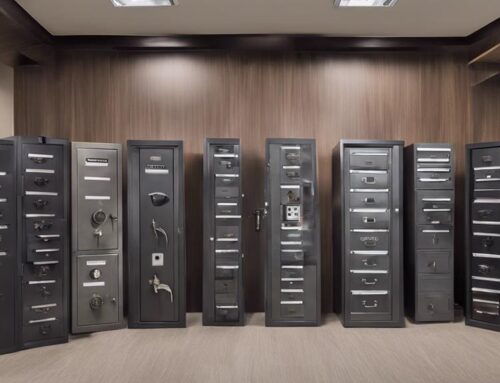Choosing between safes and lockboxes depends on your security needs. Safes offer high-security storage with robust materials, advanced locking mechanisms, and protection against theft, fire, and water damage. They’re ideal for valuables like cash, jewelry, and important documents in fixed locations with infrequent access. Lockboxes, however, are portable and provide basic security with simple locks, suitable for items requiring moderate protection and frequent access. They lack the advanced safeguards of safes but offer ease of transport and quick retrieval. To make an informed decision about safeguarding your possessions, consider each option’s unique features and potential benefits.
Key Takeaways
- Security Level: Safes offer superior security with advanced locking mechanisms and robust materials, while lock boxes provide basic protection with simpler locks.
- Portability: Lock boxes are lightweight and portable, ideal for frequent access, whereas safes are heavy and stationary, designed for fixed locations.
- Protection: Safes protect against theft, fire, and water damage, while lock boxes offer limited security and are less resilient to environmental hazards.
- Capacity: Safes have larger dimensions and higher capacity, suitable for bulkier items, while lock boxes are compact with limited interior space.
- Usage: Safes are for high-security, infrequent access, and fixed locations, while lock boxes are convenient for moderate security and frequent access needs.
Types of Security Containers
When deciding between safes and lock boxes, it’s important to understand the distinct types of security containers available and their specific features. Safes are designed for high-security storage, offering robust protection against theft, fire, and water. They come in various types, such as fireproof safes, water-resistant safes, and burglary-resistant safes. Each type is engineered to provide maximum protection for valuable items like cash, jewelry, or firearms. The complex locking mechanisms in safes add an extra layer of security, making unauthorized access exceedingly difficult.
On the other hand, lock boxes cater to different security needs. These portable containers offer flexibility and convenience, making them ideal for items you need frequent access to, such as keys or medications. Lock boxes typically feature simpler locking mechanisms, ensuring quick and easy access while providing a moderate level of security. Their lightweight and portable design allows for their use in various locations, enhancing their versatility.
Understanding these differences helps you make an informed decision based on your specific security needs. Whether you prioritize maximum protection or convenient access, knowing the distinct features of safes and lock boxes enables you to choose the right security solution.
Functionality and Usage
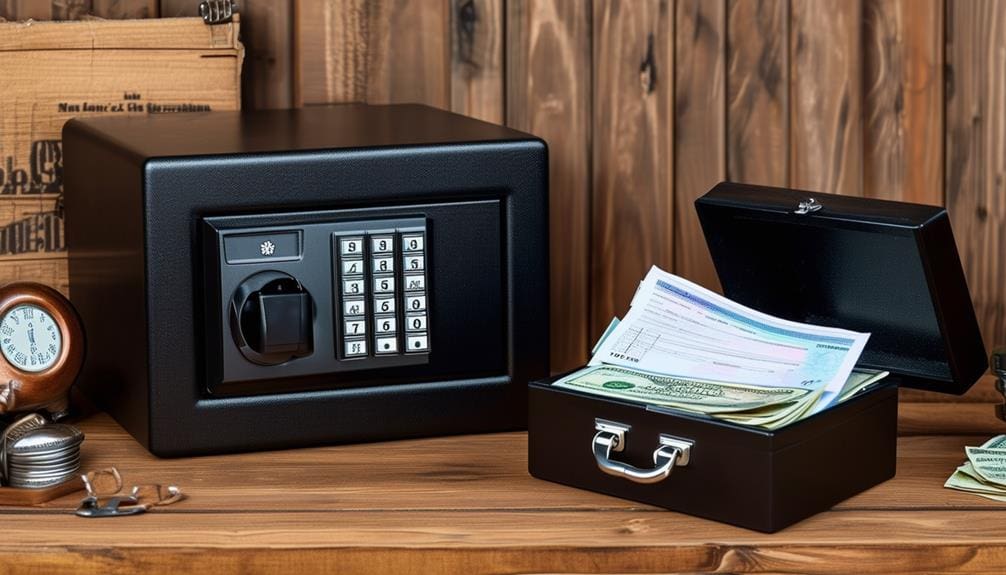
Understanding the functionality and usage of safes and lock boxes is essential for selecting the right security solution tailored to your specific needs. Safes are designed for high-security storage of valuables such as cash, jewelry, or firearms, typically installed in fixed locations. They provide maximum protection with advanced security features against theft, fire, water, and impact. This makes them ideal for situations where you don’t need frequent access to the stored items but require a high level of security.
On the other hand, lock boxes, including key safes, cater to items that need moderate protection and more frequent access. These are perfect for storing keys, medications, or other small items in various settings, offering a balance between security and convenience. They employ simpler locking mechanisms and are often portable, making them suitable for both home and business scenarios.
To summarize:
- Safes: High-security, fixed location, infrequent access.
- Lock boxes: Moderate security, frequent access, portable.
- Key safes: Specialized lock boxes for secure key storage.
- Level of security: Safes > Lock boxes for advanced protection.
Features and Operation
Safes and lock boxes each come with distinct features and operational mechanisms designed to cater to different levels of security and accessibility. Lock boxes are known for their portability and ease of use, employing various locking mechanisms such as keys, combinations, or digital codes. This makes them ideal for securing smaller items like keys or medications, where convenient access is vital. Lock boxes are typically lightweight, allowing you to easily transport them as needed, while still providing a basic level of security.
On the other hand, safes are constructed to offer maximum protection for valuable items such as cash, jewelry, or firearms. They feature complex locking systems that can include biometric scanners, digital keypads, or traditional combination locks. Safes are designed for infrequent access and are usually installed in fixed locations, emphasizing security over portability. Their robust construction and heavier weight further enhance their ability to deter theft and withstand hazards.
When considering your security needs, it’s crucial to understand that lock boxes prioritize convenience and basic security, while safes focus on providing high-security storage solutions. Each option operates with a different set of features tailored to meet specific requirements, ensuring you choose the right tool for the job.
Security Level Comparison
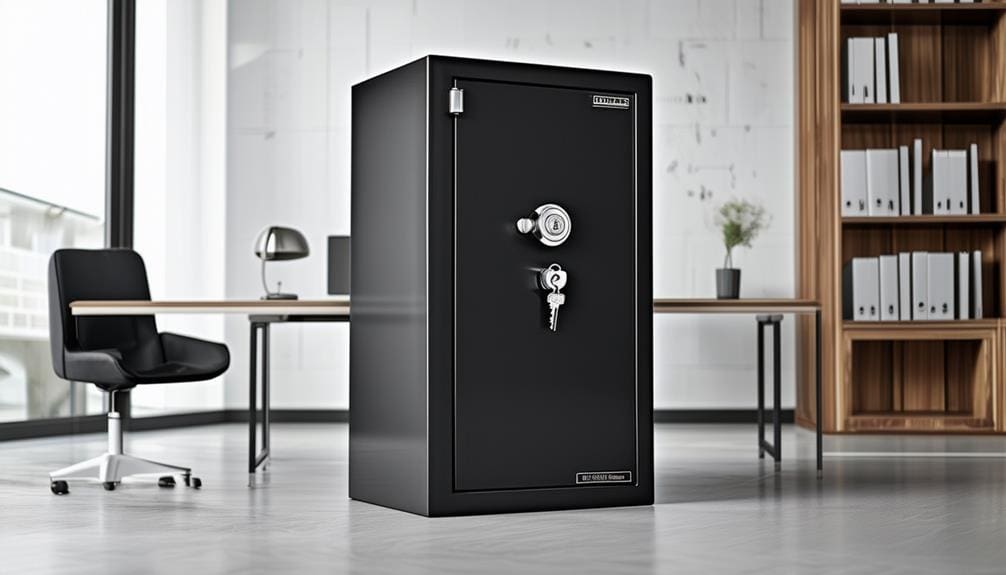
When comparing security levels, you’ll find that safes far surpass lockboxes in terms of physical protection capabilities, lock mechanism complexity, and environmental resistance factors. Safes are engineered with robust materials and advanced locking systems to withstand theft, fire, and water damage. Conversely, lockboxes offer basic security with simpler mechanisms, making them less effective against severe threats.
Physical Protection Capabilities
When it comes to physical protection capabilities, you’ll find that safes provide superior security against theft, fire, and water damage compared to lockboxes. Safes are engineered with robust features that guarantee maximum protection for your valuables. They are constructed with thick metal walls and employ fire-resistant and waterproof materials, making them ideal for safeguarding high-value items and critical documents.
In contrast, lockboxes offer basic security features, suitable for items needing moderate protection. While they are more portable and lightweight, these characteristics make them less secure compared to safes. Lockboxes are typically used for temporary storage or for items that require frequent access, such as keys or small amounts of cash.
To summarize the key differences in physical protection capabilities:
- Theft Protection: Safes have thicker metal construction and more intricate locking mechanisms, making them harder to breach.
- Fire Resistance: Safes are often rated for fire resistance, providing protection for your valuables in the event of a fire.
- Water Damage: Some safes are designed to be watertight, ensuring contents stay dry even during floods.
- Portability: Lockboxes are more portable and lightweight, but this comes at the cost of reduced physical security.
Lock Mechanism Complexity
When it comes to lock mechanism complexity, you’ll find that safes incorporate advanced technologies like digital keypads, combination dials, and biometric scanners to deliver higher security levels. These intricate locking mechanisms enhance the safe’s resistance to forced entry, making it a robust choice for securing high-value items. Digital keypads allow for customizable codes, while combination dials offer redundancy against electronic failures. Biometric scanners add an extra layer of security by requiring fingerprint recognition, ensuring that only authorized individuals gain access.
On the other hand, lock boxes typically feature simpler locking mechanisms such as key locks or basic combination locks. These provide moderate security and are more suited for items that need basic protection and frequent access. The simplicity of these mechanisms makes lock boxes convenient but less secure compared to safes.
The higher complexity found in safe locking mechanisms translates to a greater ability to withstand tampering and unauthorized access attempts. In contrast, the straightforward design of lock box mechanisms means they offer ease of use but are more vulnerable to breaches. Understanding these distinctions will help you choose the appropriate security solution based on your specific needs.
Environmental Resistance Factors
Safes excel in environmental resistance, offering robust protection against fire and water damage that lock boxes simply can’t match. When securing valuables, you need to take into account the environmental hazards that could compromise their safety. Safes are engineered precisely to withstand extreme conditions, such as fires and floods. In contrast, lock boxes typically lack the same level of environmental resistance, making them less suitable for unpredictable situations.
To illustrate the key differences:
- Fire Resistance: Safes are often rated to endure high temperatures for extended periods, protecting contents from fire damage. Lock boxes usually don’t offer the same level of fire protection.
- Water Resistance: Many safes come with water-resistant features, safeguarding your items from flooding or water spills. Lock boxes generally lack these protections.
- Material Durability: Safes are constructed from heavy-duty materials designed to resist environmental stressors effectively. Lock boxes, on the other hand, are often made from lighter, less resilient materials.
- Longevity: Due to their robust construction and protective features, safes offer long-term security against environmental damage. Lock boxes may degrade more quickly under harsh conditions.
Size and Capacity
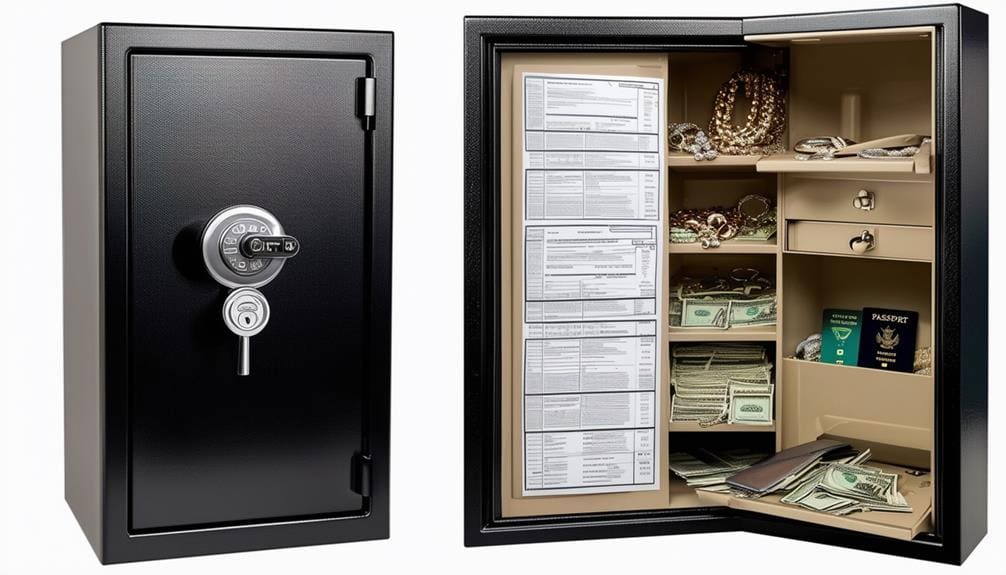
Evaluating the size and capacity of storage solutions is essential to determining whether a safe or a lockbox meets your specific needs. Safes generally offer larger dimensions and higher capacity, making them ideal for storing bulkier items like firearms or important documents. If you need to secure high-value items and require advanced security features, a safe’s ample space and robust construction will provide the necessary protection and peace of mind.
On the other hand, lock boxes are designed with limited interior space, making them perfect for smaller items such as keys, medications, or personal valuables. Their compact size offers moderate protection and is suited for items that you need to access frequently. Lock boxes provide a practical solution for easy access while still ensuring a basic level of security.
When making your decision, consider the size and capacity required for your valuables. If you need to store larger or more numerous items, a safe’s capacity will accommodate your needs. However, for smaller valuables requiring moderate protection and frequent access, a lock box will be more suitable. Evaluating your specific requirements will guide you toward the right choice for secure and accessible storage.
Portability and Accessibility
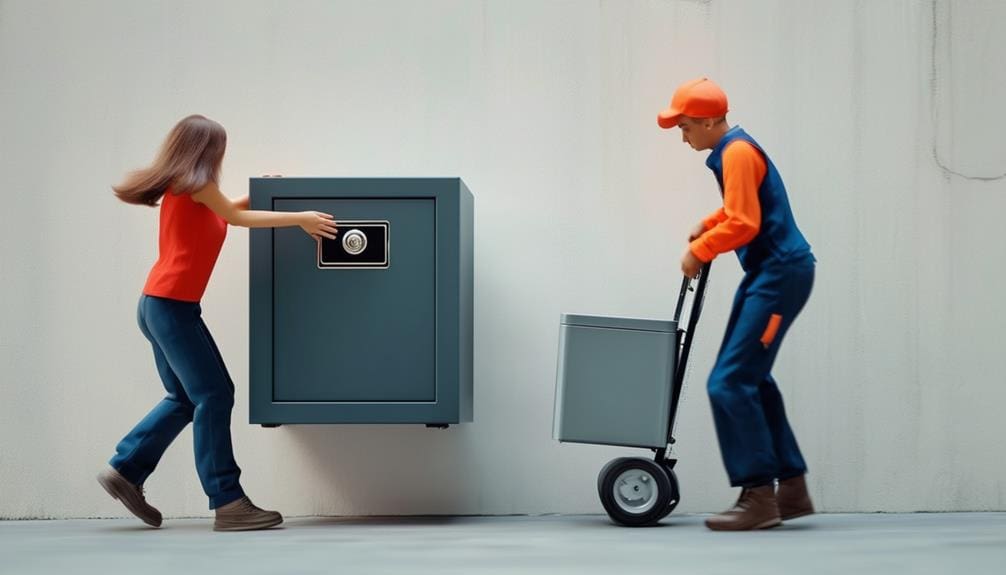
When considering portability and accessibility, you’ll find that lockboxes excel with their lightweight construction and ease of movement, making them ideal for varied locations. Their quick access options, such as simple key or code mechanisms, guarantee you can retrieve items swiftly. Conversely, safes are bulkier and more stationary, designed for maximum protection in fixed spots with complex locks that aren’t meant for frequent access.
Ease of Movement
Considering the convenience of portability and accessibility, lock boxes stand out due to their lighter weight and ease of movement. If you need to frequently move your security solution, lock boxes offer distinct advantages over safes.
- Portability: Lock boxes are designed to be lightweight, making them easy to transport from one location to another. This is particularly useful if you need to secure valuables in different settings, such as traveling or temporary storage.
- Ease of Movement: Unlike safes, which are heavy and cumbersome, lock boxes can be relocated with minimal effort. Their compact size allows you to store them in various places, providing flexibility that safes can’t match.
- Quick Access: Lock boxes often feature simple locking mechanisms, such as keys or numeric codes, enabling you to access your items quickly. This is a significant advantage in situations where time is of the essence.
- Accessibility: The design of lock boxes prioritizes user-friendly access, ensuring that you can retrieve your belongings without hassle. This ease of accessibility makes them a preferred choice for those who require moderate protection without sacrificing convenience.
Quick Access Options
While lock boxes excel in portability and ease of movement, their quick access options further enhance their practicality for everyday use. Whether you need frequent access to documents, cash, or small valuables, lock boxes provide an excellent solution. Their lightweight design and simpler locking mechanisms ensure you can move them around as needed without hassle. This makes them particularly useful if you frequently need to transport secure items between different locations.
In contrast, safes are designed with a focus on high-security storage at fixed locations. Their complex locking mechanisms and heavier build make them less suitable for quick access or frequent movement. Safes are ideal if your primary concern is maximum protection rather than quick accessibility.
To help you better understand these distinctions, consider the following table:
| Feature | Lock Box | Safe |
|---|---|---|
| Portability | High | Low |
| Quick Access | Simple Lock Mechanisms | Complex Lock Mechanisms |
| Ideal Use Case | Frequent Use, Mobility | Fixed Location, High Security |
Choosing the Right Solution
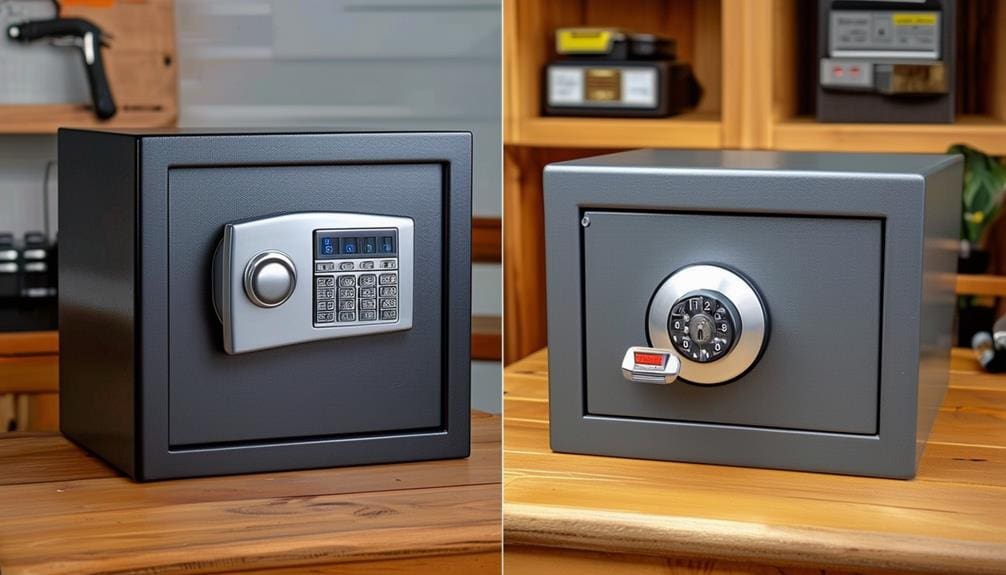
To choose the right solution between safes and lockboxes, assess your specific security needs, frequency of access, and the item types you intend to protect. By evaluating these factors, you’ll guarantee you select the ideal option for safeguarding your valuables. Here’s a breakdown to help you make an informed decision:
- Security Needs and Level of Protection: If you require a high level of protection against theft, fire, or other hazards, a safe is your best bet. Safes are built to withstand significant threats and offer robust security features. On the other hand, if your needs are more basic, lockboxes provide a simpler, portable solution.
- Frequency of Access: Consider how often you’ll need to access the items. Safes are better suited for items you don’t need to access frequently due to their secure, often intricate locking mechanisms. Lockboxes, with their easier access, are perfect for items you need to retrieve regularly.
- Portability: If you need to move your security solution frequently, lockboxes are lightweight and easy to transport. Safes are typically heavier and designed for fixed locations.
- Type of Items: Safes are ideal for high-value or sensitive items requiring maximum security. Lockboxes are suitable for smaller, less valuable items that still need protection.
Frequently Asked Questions
What Are the 4 Types of Safes?
You need to know the four types of safes: fireproof safes protect against fire damage, burglary safes offer high security, depository safes secure deposits, and gun safes store firearms safely. Wall and floor safes provide additional options.
What Is the Difference Between a Safe and a Locker?
A safe’s features offer higher security levels, complex locking mechanisms, and robust material differences. In contrast, a lockbox’s benefits include portability and ease of access. Size comparison shows safes are bulkier, providing extensive protection.
Are Lock Boxes a Good Idea?
Lock boxes are a good idea for their convenience and portability. Benefits include easy access and affordability, but drawbacks are lower security. They’re ideal for frequent usage, though safes might be better alternatives for higher security needs.
How Do I Choose a Safe Box?
Did you know that 60% of burglaries involve forced entry? When choosing a safe box, consider safe features like fireproofing and durability, size considerations for your valuables, and security levels. Lockbox benefits offer compact, accessible options.
Conclusion
When selecting between safes and lockboxes, consider your specific needs and constraints. Safes provide robust protection for high-value items, whereas lockboxes offer convenience and portability for everyday essentials. Assess the security level, capacity, and accessibility to guarantee your choice aligns with your requirements. By meticulously evaluating these factors, you’ll find a tailored solution that offers peace of mind and safeguards your valuables with the utmost discretion and efficiency. Choose wisely to secure your treasures appropriately.

